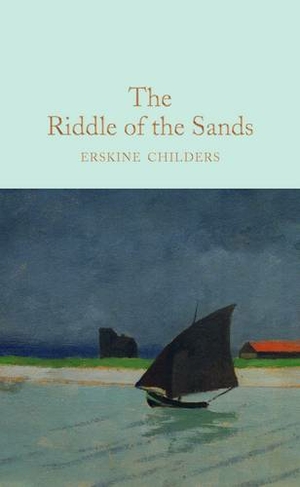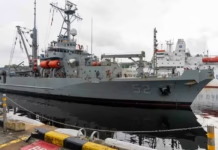
Riddle of the Sands; A Record of Secret Service Recently Achieved. By Erskine Childers. First published 1903. This edition by MacMillan Collectors Library, 2017
Reviewed by Tim Coyle
Two young English adventurers, exploring the mysterious shifting sands and estuaries of the German East Frisian Islands in a ramshackle yacht, are drawn into a covert invasion plan, hatched by a cabal of German conspirators. Forensic sleuthing exposes and disrupts the plot and alerts the British authorities to undertake timely mitigating actions.
The Riddle of the Sands was a landmark work. First published in 1903, is has been lauded as the first, and greatest, spy novel. While this may be a subjective assessment when viewed against the plethora of later offerings in this genre, it had a formidable influence in contemporary British political and military circles.
The book emerged at a time when Britain was contemplating the rise of Germany as a military and, more alarmingly, a naval power which could threaten the peerless Royal Navy in its home waters. It was a best seller and has continually remained in print. Winston Churchill credited the book for spurring the development of the northern naval bases at Rosyth and Scapa Flow.
The author, Erskine Childers, was an enigma in himself. Born in 1870, he entered the civil service as a House of Commons clerk, while pursuing his sailing passion. He served in the Boer war and the Royal Naval Air Service in World War One as an observer and intelligence officer (for which he was awarded the Distinguished Service Cross). He took up the cause of Irish Home Rule, was elected to the Irish parliament and participated in the 1922 Anglo-Irish negotiations. When the terms fell short of his expectations of full Irish independence, Childers joined the republicans in the civil war which followed. He was arrested by the Free State government, court-martialled, and executed in November 1922. Such is the drama of Childers’ life; the MacMillan edition lists 10 books related to his life.
The Riddle of the Sands plot centres on two young Englishmen: Davies, a passionate inshore sailor, and Carruthers, a sophisticated and privileged junior Foreign Office clerk. Davies, cruising in the German Frisian Islands in his yacht ‘Dulcibella’ (a converted ships’ lifeboat), invites Carruthers (a sometime friend) to join him in Flensburg. Leaving his idle and louche London lifestyle, Carruthers enters an austere and rudimentary ‘hard lying’ environment on joining Dulcibella.
Davies, rejected by the Royal Navy, is critical of the Admiralty’s obsession with large warships and their dispositions. He relentlessly explores the Frisian Islands, composed of treacherous sands and tides, searching for and documenting geographic features, dangers and infrastructure. He searches for evidence of the potential for a German ‘descent’ on Britain by asymmetric amphibious assault. Davies’ theory of this German ‘stab in the back’ would be accomplished by forces massing in the Frisian Islands and transported on barges, towed by tugs, to land on undefended British estuaries.
The British army, extended throughout the Empire, was weak at Home and the Royal Navy had no northern bases. Most of the effective ships were on foreign stations, leaving the home commands of the Nore, Plymouth and Portsmouth with few modern ships. A small force of battleships comprised the Channel Squadron, which could be reinforced by the older battleships and cruisers of the Coast Guard. Davies assessed these defence deficiencies laid English coasts vulnerable to an asymmetric German invasion from Frisian Islands staging points.
Davies’ suspicions are further reinforced by a meeting with one Dollmann in his yacht Medusa. In an ostensible offer to guide Davies via a ‘short cut’ through sand and tidal complexities in the Great Estuaries to Cuxhaven, Medusa leads Dulcibella to a stranding, which Davies suspects was an attempt by Dollmann to eliminate him; however, he survives through superior seamanship.
Following Carruthers joining Davies, the pair secretly discover Dollmann is a former Royal Navy officer (‘Lieutenant X’). They re-engage with Dollmann and meet his associates: Grimm, Bohme and Commander Von Bruning, captain of the gunboat Blitz. The four outwardly appear to be engaged in the exploration of an 18th century wreck, suspected of containing precious metals. Their operation is based on the tiny Frisian island of Juist.
Surveying the treacherous tidal sands inshore of the seven East Frisian islands by the intrepid Englishmen culminates in Carruthers’ tension-filled reconnaissance, in clammy fog, of the putative wreck recovery base. Listening furtively at a window, he gathers tiny scraps of seemingly unrelated intelligence. Leaving Davies shortly thereafter to ostensibly return to the Foreign Office, he doubles back to reconnoitre East Friesland, noting the circular railway network’s potential for transporting troops and equipment to likely invasion staging points.
Disguised and hiding in empty barges, Carruthers completes his intelligence gathering by stowing away on a tug on which the conspirators are undertaking a barge training exercise. Through subterfuge and trickery, Carruthers manages to disrupt the exercise through running the tug and barge aground.
Carruthers and Davies, now armed with evidence of the dastardly ‘stab in the back’ plan against England, confront Dollmann and accuse him of treachery against his homeland. Dollmann insists he is acting covertly as a British agent and agrees to sail to England with Carruthers and Davies; however, stricken with guilt, he disappears over Dulcibella’s side enroute. Here the narrative ends.
An Epilogue follows ‘by the Editor’ beginning ‘An interesting document, somewhat damaged by fire, lies on my study table. It is a copy (in cypher) of a confidential memorandum embodying a scheme for the invasion of England by Germany. It is unsigned, but internal evidence, and the fact that it was taken by Mr ‘Carruthers’ from the stove in the villa at Nordeney, leave no doubts to its authorship…’ The Editor then proceeds to outline its contents.
A Postscript, dated March 1903, indicates what steps were taken coincidental to the book’s printing, of ‘measures taken by the Government to counteract some of the very weaknesses and dangers alluded to above’. These included a Committee of National Defence – to create a strategic vision defining the future roles of the two military services, a site selected for the establishment of a northern naval base at Rosyth and the creation of a ‘North Sea Fleet’.
A Committee of Imperial Defence was established in 1903. The RN in Home waters was progressively reorganised from 1905 and, enlarged by the vast naval shipbuilding program, reached its final May 1912 disposition as the Home Fleet which went to war in 1914 as the Grand Fleet.
The Postscript ends, intriguingly, with …’a Manning Committee has (among other matters) reported vaguely in favour of a Volunteer Reserve. There is no means of knowing what this recommendation may lead to….’
A Royal Navy Volunteer Reserve was established in 1903 to augment the RN during war; it was underutilised in World War One but was a critical component of the RN in World War Two.
Davies, in a moment of introspection with Carruthers, blurted out his frustration at not having been accepted by the navy, but is trying to be ‘useful’. Carruthers sees Davies as ‘wedded to a fire of pent-up patriotism…’; ‘And I can’t settle down to do anything else…all I’ve been able to do is potter about in small boats, but it’s all been wasted till this chance came’. In this Davies knew he was onto something big which would redeem his obsessive desire to ‘do something useful’.
Davies then continues with his musings in response to Carruthers’ encouragement: ‘There ought to be chances for chaps like you, without the accident of a job such as this’. Davies replies: ‘There must be hundreds of chaps like me – who know our coasts like a book…They ought to make some use of us as a naval reserve’.
Have there been echoes of ‘The Riddle of the Sands’ in later history? Operation Sea Lion of 1940 was based on an amphibious operation against England by German troops in barges. It was stillborn as the Germans assessed they could not guarantee command of the seas.
The People’s Liberation Army seizure of the Chinese offshore islands during the 1949-50 war against the Nationalists was successfully achieved through the hasty establishment of a rudimentary amphibious force based on commandeered civilian junks operated by PLA soldiers with no naval experience. What became the PLA Navy was cobbled together over 18 months; it learnt quickly and neutralised the professional Nationalist navy, equipped as it was with US ships and training.
Davies’ railing against the RN’s obsession with big ship has overtones today. Many commentators are critical of expensive and vulnerable surface combatants when unmanned systems and innovative use of highly mobile small teams of amphibious troops provide an asymmetric value adding to expeditionary forces operating in archipelagic and littoral regions. The US Marine Corps is re-configuring itself for such a role.
The MacMillan Collectors’ Library edition of The Riddle of The Sands is attractively presented in a ‘pocket-sized’ hardback format with a place marker ribbon, providing a vintage period feel to the reader. Childers’ early 20th century writing style is absorbing and highly disciplined. ‘Carruthers’ depicts himself in a humorous, self-deprecatory manner when comparing his privileged background and lifestyle to Davies’ earthy, driven patriotism. As the plot thickens, Carruthers self-transitions to a cool, analytical agent-in the-field to expose the plot. The narrative is supported by four maps, drawn by Childers in fine grain detail. Close attention to these maps is essential for the reader to follow the adventure (Childers cruised in the Frisian Islands in 1897 and 1903).
The Riddle of the Sands, written by a colourful and enigmatic personality, arguably initiated proactive measures to enhance Britain’s maritime defence. That it was written by such a controversial personality adds an additional level of gravitas. The Riddle of the Sands stands in the first rank of ‘Ripping Yarns’.
(If Childers had spent his post-war time resting on his laurels – rather than becoming fatally involved in Irish politics – he might have written a sequel to The Riddle of the Sands. I can see Lieutenant Davies, RNVR, commanding a torpedo-armed Coastal Motor Boat, sowing mayhem in German anchorages. Lieutenant Commander Carruthers RNVR has a supervisory role in the Admiralty Intelligence Centre Room 40, predating Ian Fleming by a generation…)
‘



